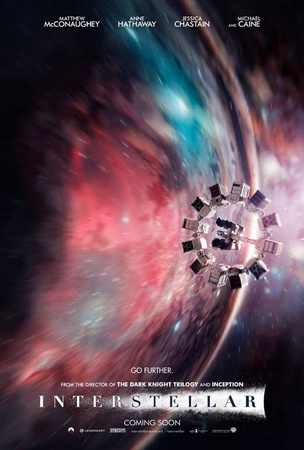Interstellar models the possibility of interplanetary, interstellar flights
Interstellar acquaints movie-lovers with space flights and times to Saturn and within black and worm holes. It brings to film-lovers accurate science fiction representations of black and worm holes and sound scientific theorizations on space events and shapes. It considers possible, albeit unlikely per California Institute of Technology’s experts, futures of blight-destroyed crops and oxygen-deficient atmospheres for asphyxiated, starved Earthlings.
The situation drives astronaut Joseph Cooper (Matthew McConaughey) to abandon test-piloting, pursue farming, and try parenting agriculture-loving, fifteen-year-old Tom (Timothée Chalamet) and science-minded, ten-year-old Murph (Mackenzie Foy) on father-in-law Donald’s (John Lithgow) farm. Old careers nevertheless emerge in Murph’s bedroom with gravitationally anomalous free-falls of:
• books;
• coins; and
• sand.
Anomaly #3 indeed furnishes NASA coordinates.
*****
https://interstellar.withgoogle.com/
*****
















 Are Hawaiian Huakai Po Nightmarchers Avenging Halloween Thursday?on 10/02/2024
Are Hawaiian Huakai Po Nightmarchers Avenging Halloween Thursday?on 10/02/2024
 Mailing Addresses for 2023 Form 4868 Extending 1040 and 1040SR April 15, 2024, Due Dateon 04/15/2024
Mailing Addresses for 2023 Form 4868 Extending 1040 and 1040SR April 15, 2024, Due Dateon 04/15/2024
 Mailing Addresses for 2023 Forms 1040 and 1040SR Filed in 2024on 04/15/2024
Mailing Addresses for 2023 Forms 1040 and 1040SR Filed in 2024on 04/15/2024
 Mailing Addresses for 2022 Form 4868 Extending 1040 and 1040SR April 18, 2023, Due Dateon 04/13/2023
Mailing Addresses for 2022 Form 4868 Extending 1040 and 1040SR April 18, 2023, Due Dateon 04/13/2023



Comments
Interstellar, as I commented below, conduces to a filmed prequel and to a filmed sequel, if not two or even more.
Is it not interesting to imagine one sequel perhaps interested in what itinerating space invokes and another sequel perhaps interested in what inhabiting our Blue Marble invokes during the same timespan?
The film Intertellar cooperates with a filmed prequel and a filmed sequel.
Is either in the works?
Mira, Scientists cannot make Einsteinian, Newtonian, and quantum theories explain all things in regard to the universe without ending up contradicting one another. For example, the above first two theories do not account for the super-big, super-intense, or super-small whereas the last theory explains the super-small, but not in terms of gravity.
The key to a unified theory -- Stephen Hawking's "theory of everything" -- is in recognizing more than the one temporal and three spatial dimensions in which humans live and in understanding light as not only a particle but also a wave. The result is the Green/Schwarz super-string theory, which reconciles all of the above theories by situating us within a one temporal- and nine spatial-dimensioned universe variously called "brane," "bulk," and "membrane" (and short-cutted as fifth dimension -- even though there are at least ten in the theory -- in "Interstellar"). The additional dimensions reflect the curled-up, curved configurations which space outside of human endeavors assumes.
Stephen Hawking and Kip Thorne thus far find it difficult to believe that people can live in the fifth dimension even though "Interstellar" appears to be saying that humans create the tesseract (cube within a cube) and help Coop (Matthew McConaughey) communicate with his daughter Murph (Jessica Chastain). It nevertheless may be possible that what happens in the fifth dimension can be witnessed by humans. Things that are moved around by poltergeists or that go bump in the night may be communications -- effected through gravity -- from the fifth dimension!
It's an extremely enlightening and entertaining endeavor to read Kip Thorne's book "The Science of Interstellar" -- which is full of helpful explanations and illustrations -- and see the movie.
The older version with Michael Rennie is one of my absolute favorite science fiction films even though I'm a fan of Keanu Reeves, particularly in "47 Ronin," "John Wick," "The Matrix" series, and "Much Ado About Nothing."
Joseph Lockard Martin, the "gentle giant" who plays Gort in the black-and-white version, also appears in another favorite of mine, "Invaders from Mars."
Oh, I forgot to say that I never thought about multiple dimensions and unexplained events in the same breath. I really should read more. And I do read science fiction now and then. Glad to read your comments about this film.
I saw The Day the Earth Stood Still just the other day on TV. Saw it for the second time. But you're right, the title points to an earlier film. I'll order it from Amazon :). I see it has a high rating on imdb as well. I enjoyed the Keanu Reeves film too, and I really like Jennifer Connelly :)
Mira, The film is appealing to non-scientists because of the adventures and to scientists because of the accuracy. For example, if people can live in dimensions outside what we know on Earth, then their presence can be detected by unexplained events, such as books falling mysteriously off stable shelves, dust forming into coded patterns, and second-hands messaging in Morse code.
An action at the end and a comment regarding the cube within a cube lead me to believe that there may be a sequel (which hopefully will not take the decade that Interstellar experienced, from ideation to production).
I hope that you will have an opportunity to see this science fiction film (one of my favorites after the original The Day the Earth Stood Still).
I've somehow missed this film at the cinema. I'll keep an eye out for it to see it on TV. Thanks for the review :) I appreciated your brief Morse interlude as well, as I didn't know that much about it, only that it's dots and letters :)
sheilamarie, The deeper I go into the science, especially as explained by theoretical physicists such as Stephen Hawking and Kip Thorne, the more fascinating film depictions of such mind-challenging concepts become.
But this film also may be enjoyed simply as an adventurous trek in space.
Although I can't pretend to understand this stuff, I appreciate your review.